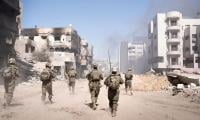The writer is a freelance columnist and former newspaper editor.
The credibility of news and the information received by people is important to their sense of their involvement in the affairs of any country. Unless they are aware of happenings and at least sure up to a certain degree that they know the truth, they will always feel left out and abandoned – like viewers at a sporting event who can hear the roars of the crowd but have no idea who has hit the ball for a six or which team has scored a goal.
While credibility has always been a somewhat disputed factor as far as Pakistan's history of journalism, and other forms of information dissemination go, it has now hit a new low. An example of this came in the frenzied attempts to pin down the number of people present at the PDM gathering in Lahore last week. Some television channels insisted the number was no more than two or three thousand. Others put it at nearly 50,000, and most said it was somewhere in between.
The vast difference in numbers meant that people actually had no idea what was going on, or who was telling them the truth and who was twisting or manufacturing the facts. The widespread rumours of pressure to present only some facts or broadcast only selected events naturally adds to the sense of uncertainty or being left adrift in a churning sea aboard a vessel that cannot be navigated or its precise location ascertained.
This lack of freedom to tell the whole truth is a common feature in journalism today. Because of pressure on newspapers as well as electronic channels, journalists are pressured into not presenting the news that they convey to millions of people around the country the way they would like to. The result, of course, is that people have begun to see through this and no one really believes the facts presented to them, or else chooses to believe what they like based on their own ideological opinions.
This is extremely dangerous. It breeds conspiracy theories and means people have no access to reliable relevant news or information when they require it or when it is necessary to guide them in any way or simply offer a reliable indication of what's happening in the country. In any democracy the involvement of the people, at least at the level of knowing what's happening, is obviously extremely important.
The situation has now become so chaotic that different newspapers and different channels convey totally different kinds of news, different facts, different figures and different details. Some broadcast particular events, others steer away from them completely. They also design talk shows to reflect a particular kind of opinion, based on what the orders are from those who control these channels, and their content.
While international watchdog bodies as well as local ones have strongly criticised the pressure placed on Pakistan's journalists, the harassment they face, the vitriolic comments made on social media directed towards them – and particularly towards female journalists and anchor persons – continues unabated. Some would argue it is growing worse.
There has been less analysis of what news is actually put out. The fact is that there is now simply no way for people to know the truth. Many have stopped, according to surveys, reading newspapers or watching television channels all together. Instead they rely on the smartphones constantly in their hands and visit websites or watch YouTube videos to try and assess what the situation may be. This is becoming the most convenient way to access news.
But does it give them a real opinion on what is going on, a real depiction of events as they unfold? This is open to dispute. Many social media channels, and all the posts scattered across social media are of course not subject to any kind of checks or any kind of regulation. This does not mean that they should not be allowed to function or be broadcast. But people must have some channels through which they can acquire news that at least intends to be reliable even if reporters sometimes make mistakes, or there are errors in judgement in assessing the number involved in a march or in a crowd.
Around the world, the numbers at rallies are always difficult to accurately determine. Today this process is often undertaken scientifically, by measuring the number of people that fit into a particular frame on the screen, or into a certain measured body of space, so that numbers can be counted. This is not entirely an accurate method either. But it does give some idea of what is happening at a particular public event. On the other hand, in Pakistan channels tend to simply come up with numbers that seem to have been pre-decided.
Real journalism is in many ways dead. Even those on YouTube do not always present the truth. Many are controlled by persons or bodies who are not involved in the news business, but simply interested only in meeting their own specific interests. Ethics have largely vanished and even media professionals who wish to stick with them really have little opportunity to do so. There is too much else involved.
The situation is a dangerous one. It means that anything can be concocted and anything can be put across and presented as news. In many ways, we are now even more limited in our ability to gain the truth from the media than was true in the days of General Ziaul Haq, when splotches of blank space appeared on pages depicting news that had been lifted off by censors.
The dangers of this current situation are many for the people of the country who have a right to information under the constitution of Pakistan as well as for others including political parties, who should be making a wider effort to ensure there are fewer restrictions on journalists and more ability to put across what is the truth or what is closest to objective facts as witnessed by a particular journalist. Of course, as experts such as Noam Chomsky have long established, there is no absolute objectivity in news – but it can be a goal towards which journalists aspire even if they are never able to attain it.
Today in Pakistan, they no longer try and move towards it, because they know it is not possible. Other pressures and other means of controlling information govern what goes out on a media channel or in a newspaper. It is difficult to know if this will change. At the moment, there seems to be less possibility of this as threats, harassment, and vicious social media attacks increase.
The future seems to be a dark one. Certainly, there is no room for a free or independent media in the country. And while similar pressures are faced in other countries, Pakistan has now become a place where valid information is very difficult for ordinary people to gain access to and as such, gather together any understanding of the events that are taking place around them in a time of much uncertainty.
Email: kamilahyat@hotmail.com
Representational image. — APP FileOnce again there is debate surrounding the National Finance Commission Award,...
Pakistani human rights activist and Supreme Court lawyer Asma Jahangir died on February 11, 2018. — AFPAn annual...
Representational image. — APP FileThe meltdown of Pakistan’s economy needs immediate attention. Political unrest...
A health worker administers polio vaccine drops to a child during a door-to-door polio vaccination campaign in Lahore,...
Armed militants of the banned Tehreek-e-Taliban Pakistan pose for a photograph in Orakzai Agency. —...
An aeroplane of the national flag carrier of Pakistan is seen in this file photo. — AFPWhile Pakistan considers...







